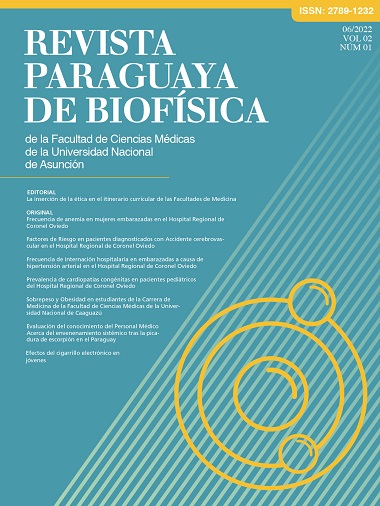Frequency of hospital admission in pregnant women due to arterial hy- pertension in the Regional Hospital of Coronel Oviedo
Abstract
Hypertensive disorders are the most frequent medical complications during preg nancy and represent the leading cause of maternal mortality worldwide. During pregnancy, four types of hypertensive disorders of pregnancy have been identified: preeclampsia-eclampsia, chronic hypertension, chronic hypertension with superimposed preeclampsia-eclampsia, and gestational or transient hypertension of pregnancy. The general objective of the study was to determine the frequency of hospital admission in pregnant women due to hypertension at the Regional Hospi tal of Coronel Oviedo in 2021. All hospitalized pregnant women who attended the Regional Hospital of Coronel Oviedo, 2021 were included. 864 pregnant women were included. A total of 864 pregnant wo men were included, of whom 45 presented arterial hypertension. It was observed that patients with an age range between 35-40 years presented 35.7% of cases with preeclampsia and eclampsia. Com- plications that usually occur include acute pulmonary edema, decreased urinary volume, neurosensory exaltation, seizures and preterm delivery, the patients in our study did not present any of them except for the latter which was observed in 8.9% of the hospitalized patients. No maternal deaths associated with hypertensive disorders of pregnancy were recorded in this study, and medical discharge was the outcome for 100% of the patients hospitalized with hypertensive hypertension. The results obtained in relation to pregnant women with arterial hypertension who were hospitalized can be considered satisfactory, not only depending on hospital care, but also on a strong and consolidated Maternal and Child Care System that fulfills a whole cycle of repro ductive health and is based on prevention, promotion and early diagnosis by Primary Care. For the control of arterial hypertension it is necessary to take into account the associated risk factors in order to prevent it.
Downloads
References
(1) Saftlas AF, Olson DR, Franks AL, Atrash HK, Pokras R. Epidemiology of preeclampsia and eclampsia in the United States, 1979-1986. Am J Obstet Gynecol [Internet]. 1990
(2) Vidal Plúas, Johanna Georgina, Patiño Zambrano Walter Alejandro, Solorzano López, Luisana Belen, Berruz Alvarado, Steven Javier, et al. Factores causales de hipertensión arterial en mujeres durante la gestación. Revista Científica Mundo de la Investigación y el Conocimiento. [Internet]. 2018. Vol. 2 núm., 2.
(3) Lindheimer MD, Taler SJ, Cunningham FG, American Society of Hypertension. ASH position paper: hypertension in pregnancy. J Clin Hypertens (Greenwich) [Internet]. 2009
(4) Villar J, Say L, Gülmezoglu AM, Meraldi M, Lindheimer MD, Betran AP, et al. Eclampsia and pre-eclampsia: a health problem for 2000 years. [Internet]. 2003.
(5) European Society of Gynecology (ESG); Association for European Paediatric Cardiology (AEPC); German Society for Gender Medicine (DGesGM); Regitz- Zagrosek V, Blomstrom Lundqvist C, Borghi C, Cifkova R, Ferreira R, Foidart JM, Gibbs JS, Gohlke-Baerwolf C, Gorenek B, Iung B, Kirby M, Maas AH, Morais J, Nihoyannopoulos P, Pieper PG, Presbitero P, Roos-Hesselink JW, Schaufelberger M, Seeland U, Torracca L; ESC Committee for Practice Guidelines. ESC Guide- lines on the management of cardiovascular diseases during pregnancy: the Task Force on the Management of Cardiovascular Diseases during Pregnancy of the European Society of Cardiology (ESC). Eur Heart J. 2011 Dec;32(24):3147-97.
(6) Valarino G, Mora A, Cabrera C, Durán I, Díaz Y, González S, et al. Eclampsia: Morbilidad y mortalidad materna y perinatal. Rev Obstet Ginecol Venez [Inter- net]. 2009 [citado el 22 de noviembre de 2022];69(3):152–61.
(7) Dulay AT. Preeclampsia y eclampsia [Internet]. Manual MSD versión para profesionales. [citado el 22 de noviembre de 2022]. Disponible en: https://www.msdmanuals.com/es/professional/ginecolog%C3%ADa-y- obstetricia/anomal%C3%ADas-del-embarazo/preeclampsia-y-eclampsia
(8) Pinedo A, Orderique L. Complicaciones maternoperinatales de la preeclampsia- eclampsia. Rev peru ginecol obstet [Internet]. 2015 [citado el 22 de noviembre de 2022];47(1):41–6. Disponible en: https://sisbib.unmsm.edu.pe/BVRevistas/ ginecologia/vol_47n1/complicaciones_mater.htm
(9) Pérez Arturo, Prieto Clavero Eilyn, Hernández Placía Rosa María Preeclampsia grave: características y consecuencias. 2015;120-127.
(10) Ghulmiyyah L, Sibai B. Maternal mortality from preeclampsia/eclampsia. Semin Perinatol. 2012;36(1): 56-9.
Downloads
Published
How to Cite
Issue
Section
License
Copyright (c) 2023 Ana Belén Rolón Fernández, Paola Beatriz Rolón Peralta, Marina Monserrat Sanguina Oviedo, Erika Manuela Vertuan Benítez, Luciana Villalba Duarte, Zaida Amalia Villamayor Riveros

This work is licensed under a Creative Commons Attribution 4.0 International License.





